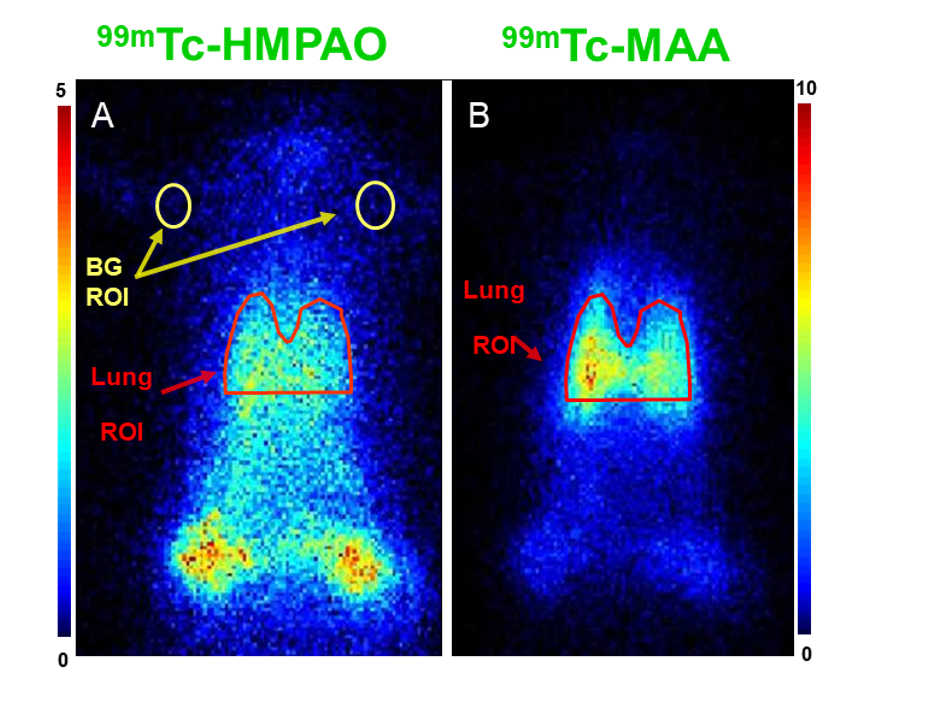Contact Us
For additional information about the Computational Lung Physiology Laboratory, Contact the CLPL.
Report a Problem
To report a problem with this website, contact BME Communications or report an accessibility issue.
ARDS is a devastating disorder characterized by rapidly progressing hypoxic lung failure, whose incidence of a severe condition is ~200,000 new cases in the U.S. alone each year with a mortality rate of ~40%. This high mortality rate is due to multiple factors, but key are the lack of clinical means for early detection, limitations of current prognostic scores for risk stratification of mild ARDS patients, as well as the lack of effective therapies to supplement supportive care. Molecular imaging of labeled biomarkers has potential to be an effective tool for early detection and monitoring of lung injury and disease, and the CLPL has pioneered the use of novel biomarkers—together with imaging hardware, software, and protocols—to examine mechanisms and pathways involved in Acute Respiratory Distress Syndrome.
 The CLPL is using single-photon emission computed tomography (SPECT) lung imaging of radiolabeled biomarkers. The utility of a given SPECT biomarker is dependent on the sensitivity and specificity of its uptake in the lung to changes in a particular cellular process involved in the pathogenesis of ARDS. Technetium-labeled biomarkers are being used to probe oxidative stress, inflammation, and mitochondrial dysfunction pathways through the use of molecular images. One objective is to determine if imaging can be used to stratify the risk of progression from mild to severe ARDS. We are also using imaging of genetically-modified animals to determine the role of particular signaling pathways in the disease progression as well as in potential protection afforded by novel therapies. The overall objective is to obtain mechanistically-based prognostic information that can be readily translated to the clinic in order to personalize ARDS prevention and treatment, improve outcomes, and reduce healthcare costs.
The CLPL is using single-photon emission computed tomography (SPECT) lung imaging of radiolabeled biomarkers. The utility of a given SPECT biomarker is dependent on the sensitivity and specificity of its uptake in the lung to changes in a particular cellular process involved in the pathogenesis of ARDS. Technetium-labeled biomarkers are being used to probe oxidative stress, inflammation, and mitochondrial dysfunction pathways through the use of molecular images. One objective is to determine if imaging can be used to stratify the risk of progression from mild to severe ARDS. We are also using imaging of genetically-modified animals to determine the role of particular signaling pathways in the disease progression as well as in potential protection afforded by novel therapies. The overall objective is to obtain mechanistically-based prognostic information that can be readily translated to the clinic in order to personalize ARDS prevention and treatment, improve outcomes, and reduce healthcare costs.
Pharmacokinetics of Tc-HMPAO in isolated perfused rat lungs. (Clough AV, Barry K, Rizzo BM, Jacobs ER, Audi SH) J Appl Physiol (1985) 2019 Nov 01;127(5):1317-1327 PMID: 31414953
Protection by Inhaled Hydrogen Therapy in a Rat Model of Acute Lung Injury can be Tracked in vivo Using Molecular Imaging. (Audi SH, Jacobs ER, Zhang X, Camara AKS, Zhao M, Medhora MM, Rizzo B, Clough AV) Shock 2017 10;48(4):467-476 PMID: 28915216
99MTc-Hexamethylpropyleneamine Oxime Imaging for Early Detection of Acute Lung Injury in Rats Exposed to Hyperoxia or Lipopolysaccharide Treatment. (Audi SH, Clough AV, Haworth ST, Medhora M, Ranji M, Densmore JC, Jacobs ER) Shock 2016 10;46(4):420-30 PMID: 26974426
The Computational Lung Physiology Laboratory has a strong commitment to training the next generation of scientists interested in using state-of-the-art computational techniques to improve human health. Research opportunities are available for undergraduate and graduate (MS and PhD) students alike. For more information on joining our team, Contact the CLPL !